Lecture VIII
Dornach,
January 17, 1917
The pictures we shall show
today will enable us to give a kind of recapitulation of various things
that came before our souls in former lectures. I shall draw attention
today to further aspects, arising out of what we have said before. In
the course of these studies, we have distinguished between the more
Southern European and the Northern or Mid-European artistic streams
and we have indicated characteristic aspects of these two. I do not
wish to repeat what has already been set forth. Today we are able to
show some further reproductions of pictures by Raphael, and I wish to
say a few words about him, unfolding — if I may so describe it
— a more special outcome of our ideas concerning the artistic
genius of the South.
Anyone who lets Raphael's
creations work upon his soul, will admit that in Raphael — with
respect to certain artistic intentions — the highest ideal has
been attained. When we let them work upon us and try to understand them,
we ask ourselves again and again: What is it that comes to expression
in his works, and how does it stand in relation to the World? Think
for a moment from this aspect of the Madonna della Sedia, — how
this picture is placed in a great world-perspective: It is so, indeed,
in all directions. To begin with, you may consider the picture as an
outcome of the Christian world-conception. So perfectly does it express
this theme: The Birth of Christ Jesus in connection with the Madonna,
that we must say, 'The ides, the meaning, the impulse, the world-historic
significance which it is desired to express, has here been expressed
by means that cannot ever be transcended.
From a certain point of
view you cannot imagine a further enhancement of this theme —
the Madonna with the Jesus Child — in its impression on the human
soul. One of the ideas of the Christian conception of the world has
come to expression here in the highest imaginable way, seen from a certain
aspect.

1. Raphael. Madonna With Child.
And now let us look at the
picture for a moment as though we knew nothing of the Christian
world-conception. Let us consider it in the way Herman Grimm once spoke
of it, simply as an expression of the deep mystery of the relation of the
mother to the child. A mother with her child: Once more, the highest means
of expression have been found by Raphael for one of the most mysterious
themes in the whole Cosmos, as it lies before us human beings living
in the Physical. Thus even if we take the pure picture of Nature —
the mother and child — apart from the world-historic happenings,
once more the thing is perfect in itself, the highest of its kind.
It is always so with Raphael.
His themes are of universal significance, and perfectly expressed, —
the means of expression proceeding from those streams and influences
which we recognise as characteristic of the South. Always, however,
his themes must be seen in the context of great universal meanings.
We can regard them from a Christian aspect (and the above two points of
view are by no means the only ones), — looking at it in a Christian
way, the theme places itself at once in a great context of Nature. Again
it rises free from the individually human; we seem to forget the human
being that worked to create it — the human being, Raphael himself.
Behind the artist stand great cosmic perspectives — world-conceptions
coming to expression in him. This, indeed, is to characterise such an
artist as Raphael, as the artist of an epoch that was drawing to it
close: the Fourth Post Atlantean epoch. Such epochs, when they draw
near their end — or when their inner essence reaches beyond the
boundary of times, often bring forth their very highest.
We shall presently see how
very different it is when we consider in this light, say, the personality
of Albrecht Dürer. There it is altogether different. But you might
also think of the Sistine Madonna, even as we have now spoken of the
Madonna della Sedia. Again we should have to say: What is here placed
before us interests us, above all, inasmuch as it stands out against
the background of a great world-conception. Without this background of a
great world-conception, the Sistine Madonna is, indeed, unthinkable.

2. Raphael. Sistine Madonna With Child

3. Raphael. Sistine Madonna With Child (detail)
Looking at some of Raphael's
pictures today, let us bear in mind the aspect which has thus been
characterised. For Raphael to create in this way — for his pictures
to arise out of a mighty world-perspective — something of cosmic law
and principle had to be working in his very soul. This is, indeed, the
case. It comes to expression in the remarkable course of his life, which
was already emphasized by Hermann Grimm. Raphael's work takes its course
in regular cyclic periods. At the age of twenty-one he creates the
Sposalize; four years later the Entombment; four years after
this he completes the Frescoes of the Camera della Segnatura; four
years later, once again, the Cartoons for the tapestries in the
Vatican and the two Madonnas. And finally, four years after this, at the
age of thirty-seven, he is working at the Transfiguration, which
stands unfinished when he leaves this physical plane. In cyclic periods
of four years, something of the nature of a cosmic principle works in
Raphael. Truly, we here have something that proceeds from a great cosmic
background. Hence Raphael's work is so strongly separated from his
personality. Again and again the question comes to us: How is it that
the themes — and they are world-historic themes — come to
expression in his work so perfectly; so self-contained, so inwardly
complete?
Down to this day, the study
of Art derives — more than from any other source — from
that great Art in the center of which is Raphael.
The study of Art in the
exoteric life today is more or less of this kind. All its available
ideas have been learned from the Art which finds its highest expression
in Raphael — the Art of the Italian Renaissance. Thus in the outer
life the concepts to express this Art are the most perfect, and all
other Art is measured by this standard. The works of this Art are the
ideal, and we have few words at our disposal, few concepts and ideas,
even to speak of any other streams in Art, specifically different from
this one. That is the unique thing.
And now we will let pass
before our souls a number of pictures by Raphael, most of which we have
not yet seen in these lectures.

4. Raphael. The Vision of Ezekiel. (Florence,
Palazzo Pitti.)
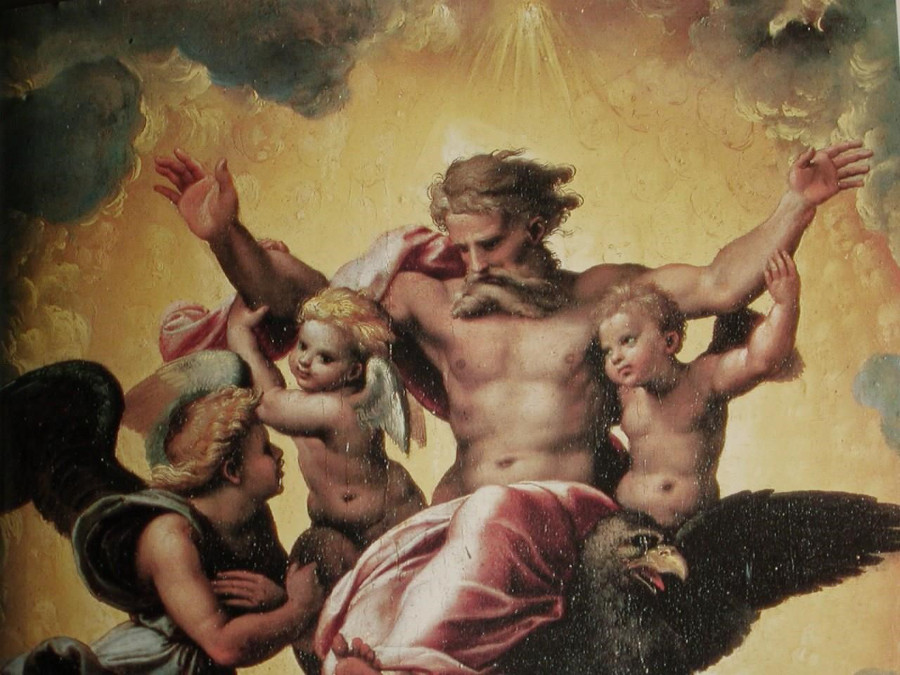
4. Raphael. The Vision of Ezekiel. (detail)
(Pitti. Florence.)
The ideas, the living
conceptions, out of which such a picture proceeded even in Raphael's time,
are naturally no longer near us today. To represent so truly this wandering
of the soul in human form through the spiritual world, would no longer be
attainable today for those who have not Spiritual Science. The animal
nature below expressed what man has cast aside from himself, but it is
still there, needless to say, even in his etheric body, and we find it
there when the etheric is freed from the physical. The union of the soul
with something childlike, as it is is represented by the angel figures
here, is an absolutely true conception. The conception corresponds to a
reality. We must consider man in his full being, such as he really is. In
recent communications on the Guardian of the Threshold we had to speak of
the Threefold being of Man. This threefold nature of man emerges
everywhere, where reference is made to the Spiritual part of man
emancipated from the Physical. We find this threefoldness in manifold
forms — not symbolic, but corresponding to spiritual Realities. And
so we find it here, in the full-grown Man related to the Child and the
Beast.


5. Perugino. The Marriage of Maria. (Vienna,
Albertina.)
Today we are able to show
a study from the Sposalizo, the picture with which Raphael's great career
as an artist properly begins. He did this at the age of twenty-one —
at the beginning of the four-year period which dominated all his work.

6. Perugino. “Sposalizo”. (Caen.)

7. Raphael. “Sposalizo”. (Milan,
Brera.)

8. Raphael. The Call of St. Peter. (London,
Kensington Museum.)
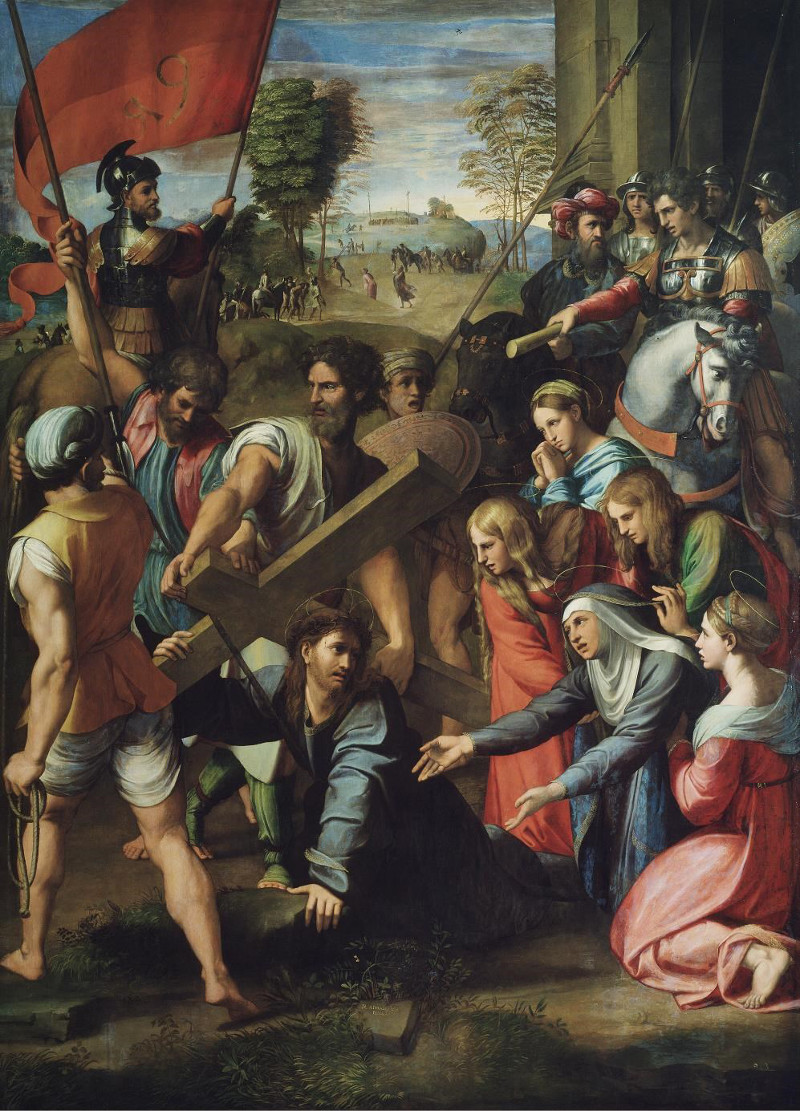
9. Raphael. The Road to Calvary. (Madrid, Prado.)
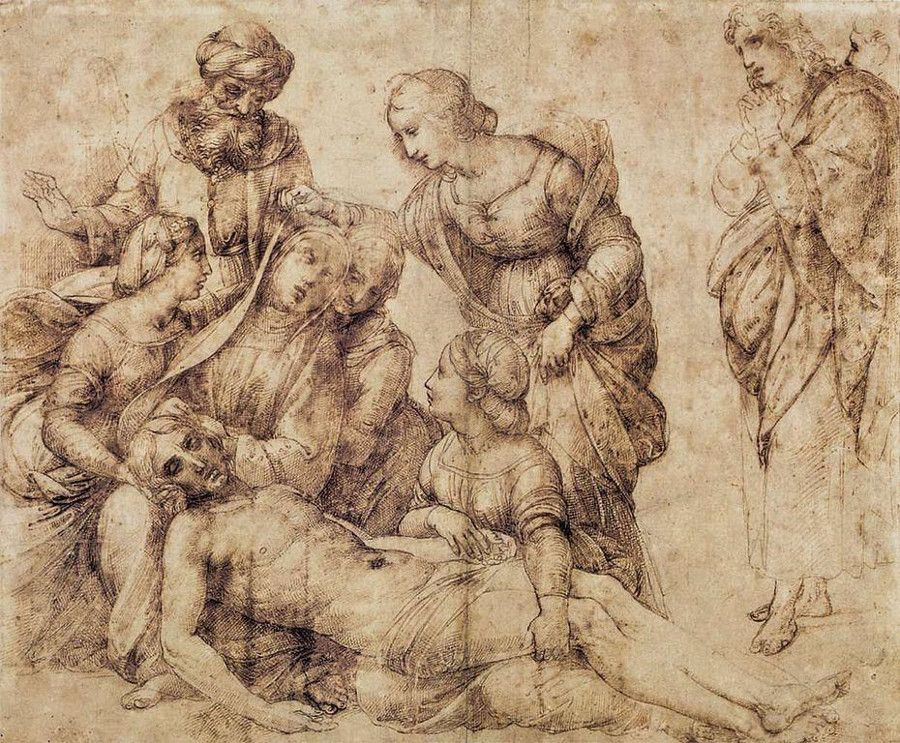
10. Raphael. Sketch of the Mourning for Christ.
(Louvre. Paris.)
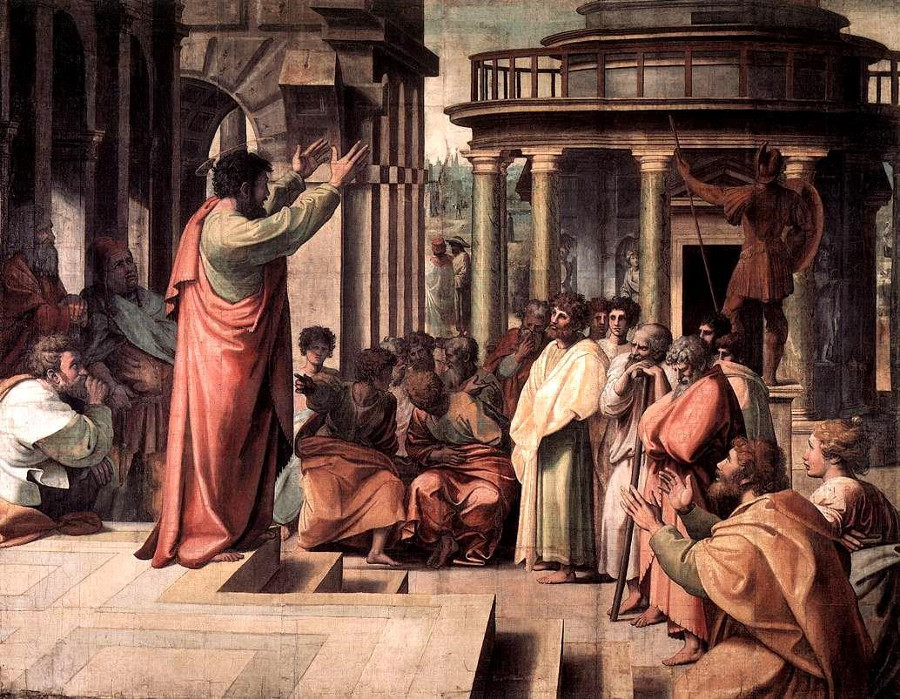
11. Raphael. Sermon of St. Paul at Athens.
(London, Kensington Museum.)
We will now show once
more a reproduction of the so-called “Disputa,” with certain
details.

12. Raphael. Disputa. (Vatican. Rome.)

13. Raphael. The Holy Trinity. (Perugia, San
Severo.)
The Holy Trinity, as it
is called.

14. Raphael. Sketch for the Disputa. (Windsor.)

15. Raphael. St. Cecilia. (Bologna.)
And now, as an example
of Raphael's portraiture: —
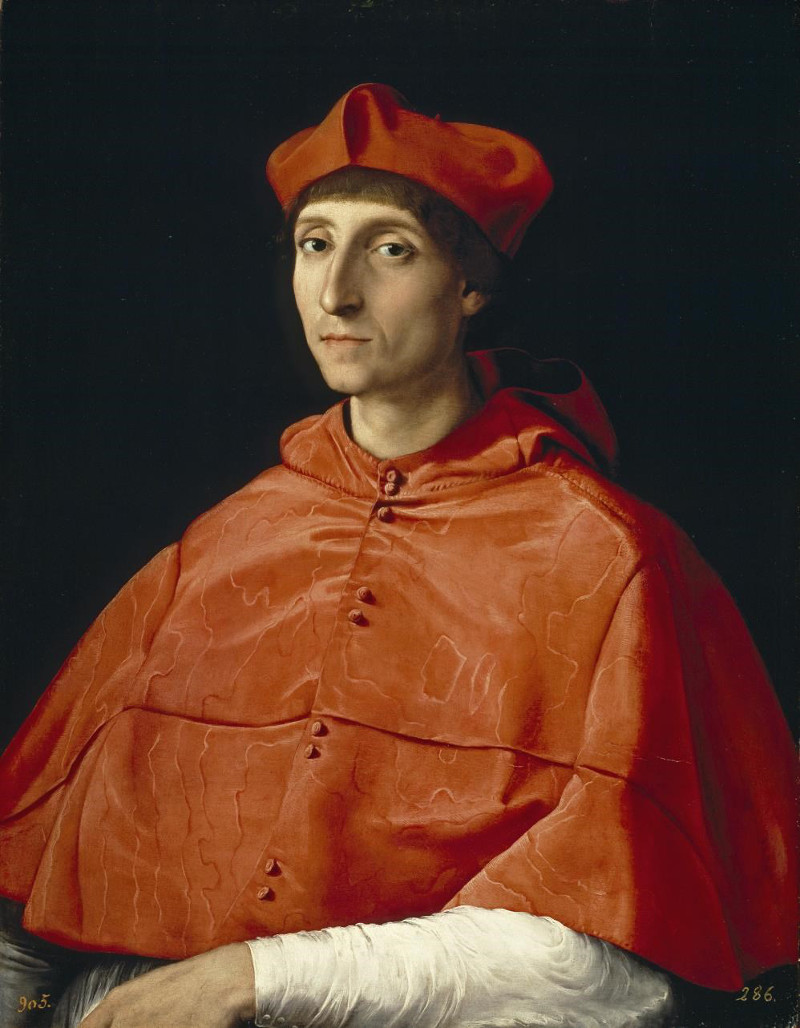
16. Raphael. Cardinal Bihbiens. (Pitti. Florence.)
The next two are examples
of his tapestries in the Vatican.
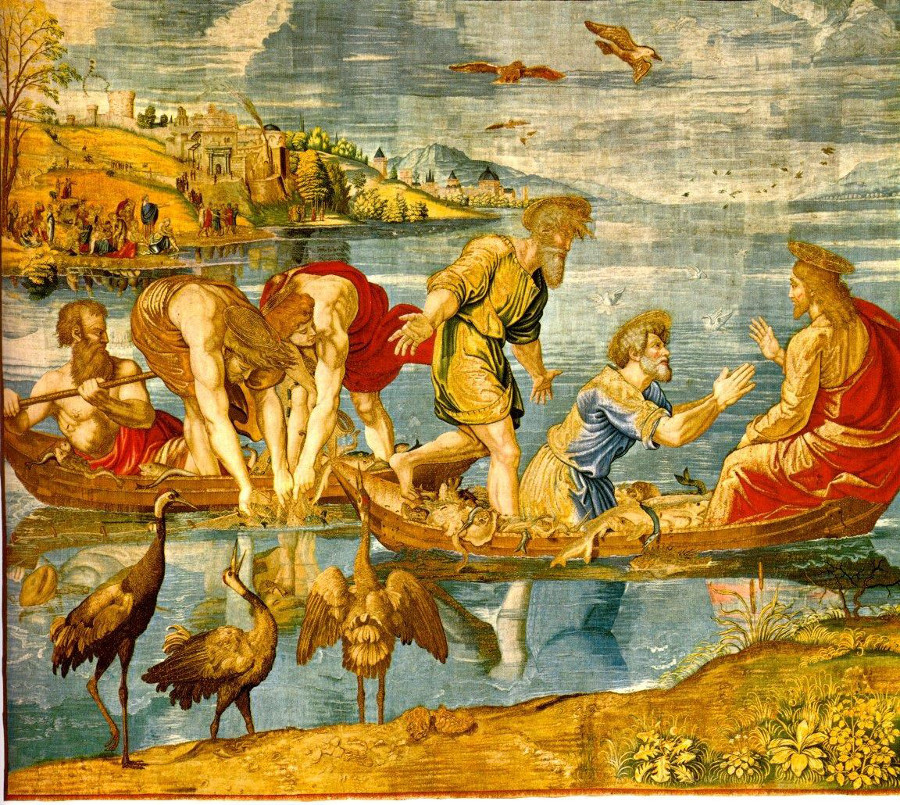
17. Raphael. The Miraculous Draught of Fishes.
(Tapestry in the Vatican.)

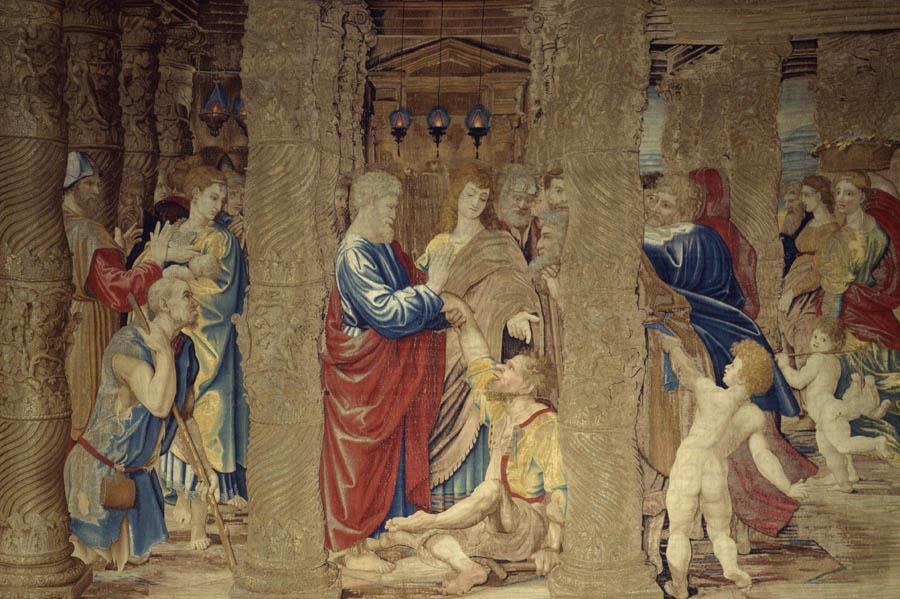
18. Raphael. The Healing of the Lame. (Tapestry
in the Vatican.)
These are the things of
which Goethe said that nothing he had known till then could compare
with them in greatness.
Looking back once more over
the pictures by Raphael which we have seen today, I beg you observe how we
may recognise in them the echoing of a mighty tradition of great Art.
Even the sketches which we have shown today reveal this most especially.
Raphael's work is the last, the highest, the closing act in a great
tradition. There is also another point I would ask you to consider.
Think of the picture of the Sermon of St. Paul and others — the
“Disputa,” for example. You may take any one of those that
we have seen today. In every case, having distinguished the subject of
the picture, you may naturally ask yourself about the event or personality
represented. But it will never be sufficient to answer: The subject
is such and such; it represents this or that. In Raphael's case you
will have to ask: How is the artist contriving to express — whatever
the subject is — in accordance with the ideas and canons of great
Art? We cannot merely ask: How would St. Paul actually have lifted up
his hand to speak? With Raphael we must ask: What angle will the arm
have to make with the body according to aesthetic laws of balance and
proportion? And so forth ... A magic breath is poured out over it
all, — a magic breath of aesthetic traditions, of harmony and
balance. Look at the boy who stands here, in this picture. It is not
enough to ask: What is going on in the soul of the boy? Your question
must, rather, be directed to these laws of artistic harmony. See how
the line of the arm, reaching out on either side, is placed into the
composition. In short, you can distinguish what is purely artistic from
the underlying subject-matter. Here, however, the artist's power is
so magnificent that it draws the subject-matter into its own sphere.
With such an artist as Raphael, we may, indeed, pronounce the word,
for it is literally true: — “Artistic truth makes all the
rest true, — compels all the rest into its circle.”
You cannot apply this saying,
in its present meaning, to the works we shall now let pass before our
souls. We will begin with one by Martin Schongauer, who died in 1488.

19. Martin Schongauer. The Road to Calvary.
Here you see the very
opposite. To begin with, the artist is simply concerned to express his
subject. No longer is there poured out over it the magic breath of a
peculiarly aesthetic truth, the climax of a great tradition. Here the
effort is, to the best of the artist's technique and ability, with the
artistic means at his disposal, to bring to expression what is there in
the souls of men. Here the world speaks to us directly — not
through the medium of a tradition of great Art.
We will now let work upon
our souls the personality of Albrecht Dürer; showing a number of
pictures which we did not see in the former lectures. In Albrecht Dürer,
whom we may speak of as a contemporary of Raphael, we have before us an
altogether different personality. It is impossible to think of Dürer's
works in the same way as of Raphael's. In Dürer's case we shall
not easily forget the personality, the human being. Not that we must
always necessarily imagine him; but the pictures themselves are eloquent
of all that is direct and intimate and near to the human soul, springing
from the soul with elemental force. Raphael paints with the ever-present
background of great world-perspectives. He is only conceivable if we
imagine, as it were, the Genius of Christianity itself painting in the
soul of Raphael. And, again, he is only conceivable as one who stands
at the close of a great epoch, during which pupils were learning from
their Masters many a tradition of aesthetic law, artistic harmony, —
learning that certain things should be done in certain ways, to correspond
with the canons of great Art.
In Raphael's works these
things are always there before us. In Dürer's work, on the other
hand, we feel in the background, as it were, the aura of the life of
the time in Middle Europe, — the German towns and cities. Invisibly
his pictures are pervaded by all that blossomed forth in the free life
of the cities, working its way towards the Reformation. Nor does he
stand before us with any cosmic perspectives in the background. It is,
rather, the ordinary individual man's approach to the Bible and to his
fellow-men, bringing his own soul to expression. The Human element can
never be separated from his works. We cannot seek in Dürer for
a cosmic principle working through his soul, as we can in Raphael. But
we may look for something intimate and deep; deeply connected —
we cannot say so too often — with the human soul, its feelings
and its seeking, its longing and striving.

20. Dürer. The Four Witches. (Etching)

21. Dürer. Hercules.

22. Dürer. Melanchthon Etching.
Here we have a portrait
of Melanchthon, the theological bearer of the Reformation, as against
Luther, who was the “priestly” bearer.

23. Dürer. “Rosenkranzfest.”
(Prague.)
This picture is now in the
“Rudolfinum” at Prague. The Pope, the Emperor and
representatives of Christianity are being crowned with roses by Mary,
the Jesus Child and St. Dominic. The two figures against the tree trunk
will be shown in detail in the next slide.


24. Dürer. Portrait of Himself and Pirkheimer.
(Detail of the above.)
Further examples of Dürer's portraiture: —

25. Dürer. Portrait of his Father. (Uffizi.
Florence.)

26. Dürer. Portrait. (Prado. Madrid.)
Looking at such a portrait,
the whole life of the time comes vividly before you. Truly, in this
sense Dürer is an historic figure of the very first rank. No historic
document tells us so well, what the people of that time were like.
We shall now show some
characteristic examples of Dürer's drawings — etchings and
woodcuts. To begin with, from his cycle on the Apocalypse —
fifteen leaves, done in 1498.
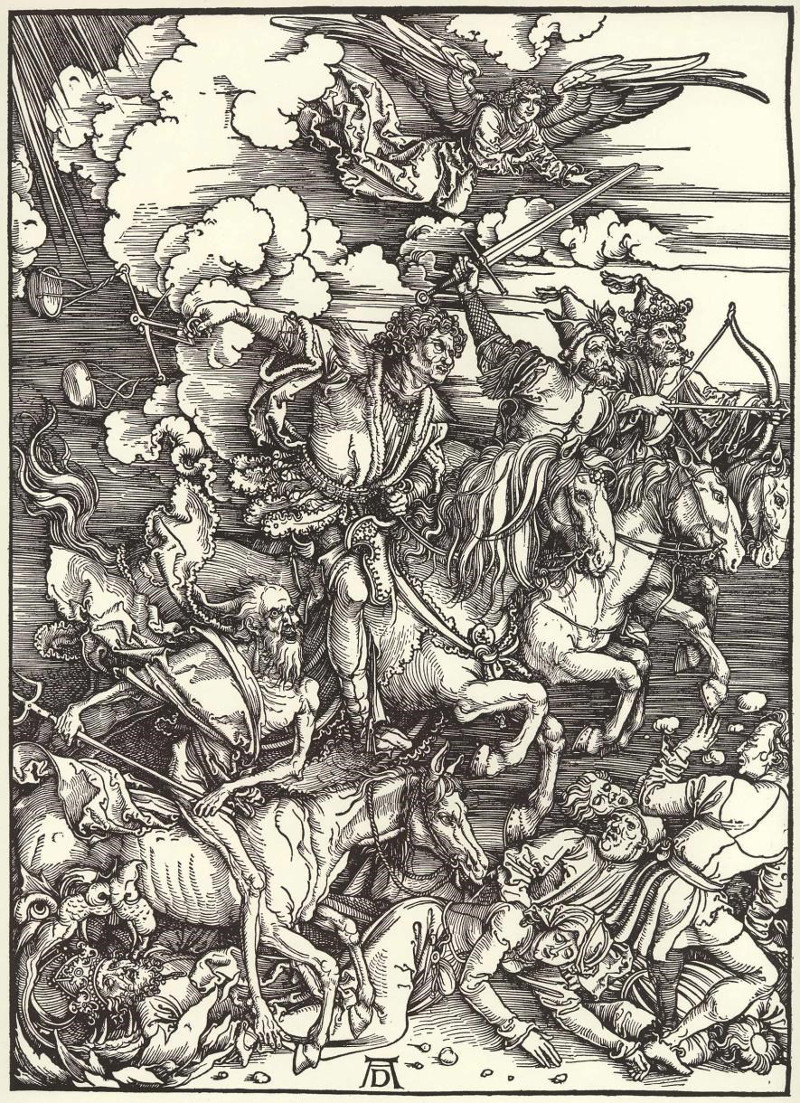
27. Dürer. The Four Horsemen of the Apocalypse.
(1498.)

28. Dürer. The Woman Clothed with the Sun and
the Seven-headed Dragon (1498.)

29. Dürer. The Adoration of the Lamb and The
Hymn of the Chosen. (1497).

30. Dürer. The Battle of the Angels. (1498.)

31. Dürer. Michael and the Dragon. (1493.)
And now we will show a number
of pictures from the series of etchings of the Passion — known
as the “Kupferstich-Passion.”

32. Dürer. The Kerchief of St. Veronica.
(Etching)
Then the motif that occurs
again and again in that time: —

33. Dürer. The Man of Sorrows. (Etching)

34. Dürer. The Scourging. (Etching)

35. Dürer. The Crowning with Thorns. (Etching)

36. Dürer. Ecce Homo. (Etching)
We will next show a number
of pictures from the Holzschnitt-Passion — of thirty-six small
woodcuts. They are extraordinarily tender and intimate. The first is
the title-page: —
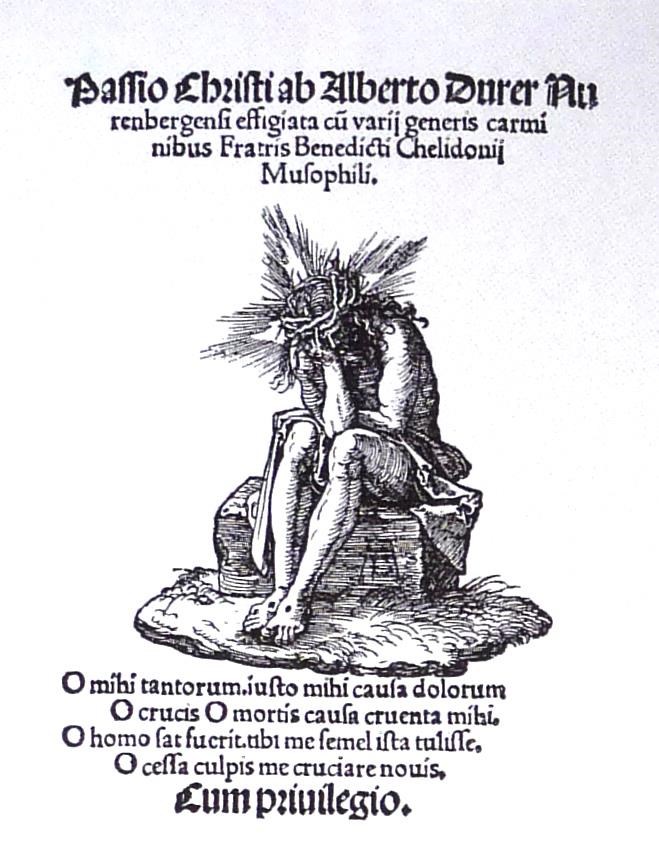
37. Dürer. Christ with the Crown of Thorns.
(Woodcut)
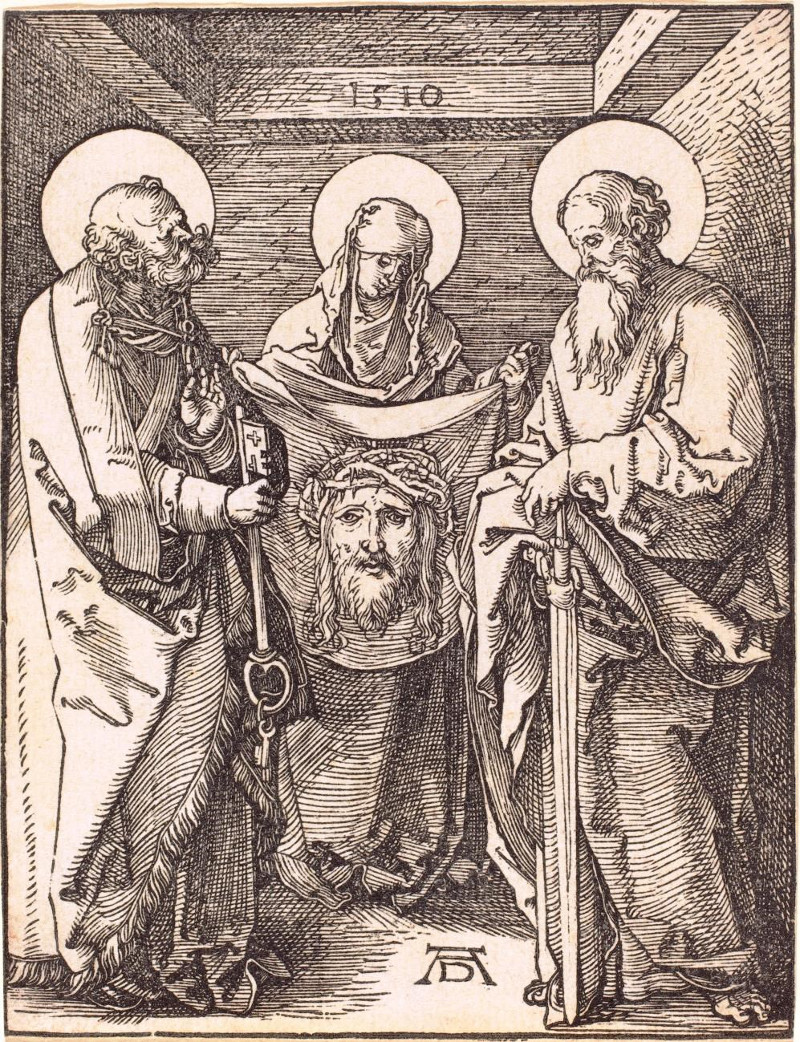
38. Dürer. Saint Veronica. (Woodcut)
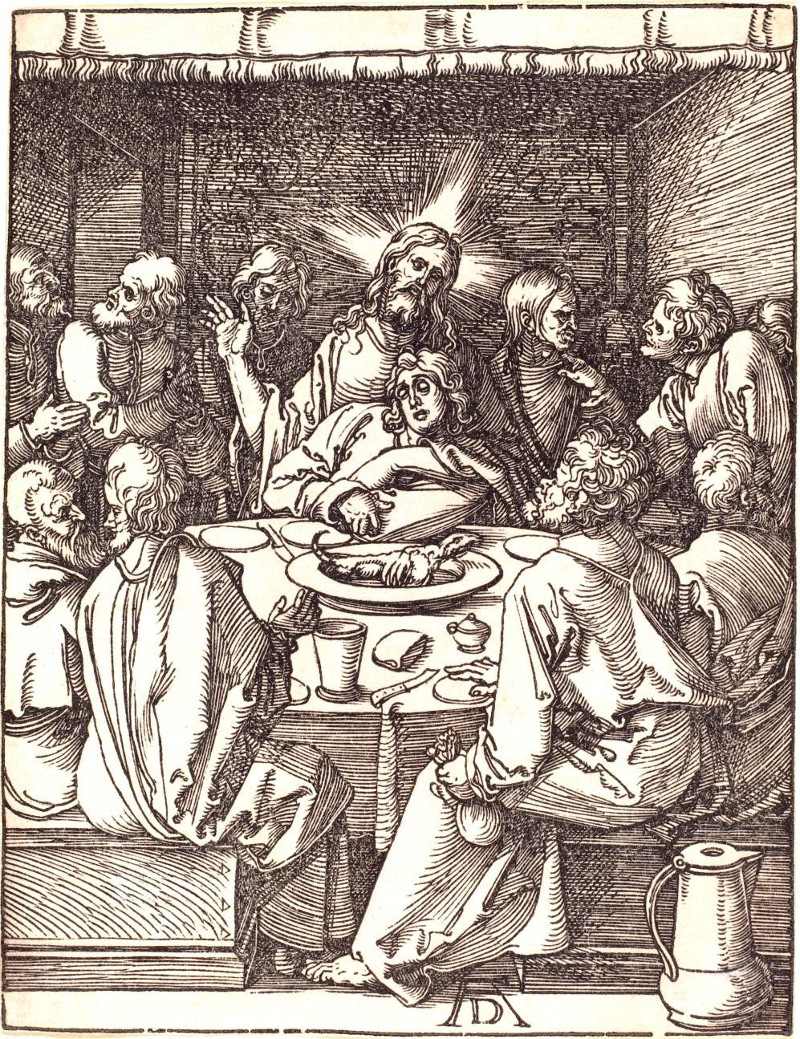
39. Dürer. The Last Supper. (Woodcut)
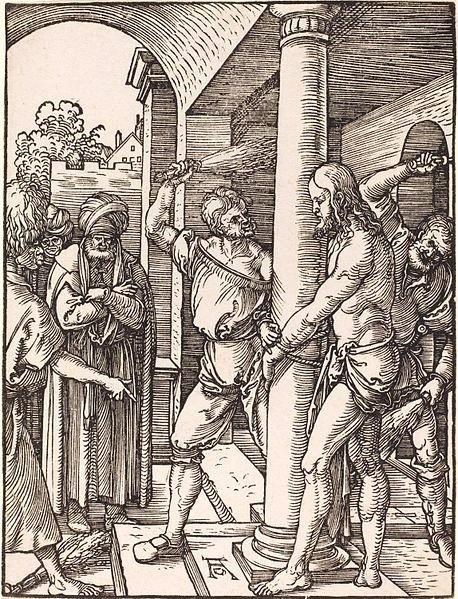
40. Dürer. The Scourging. (Woodcut)

41. Dürer. Ecce Homo. (Woodcut)
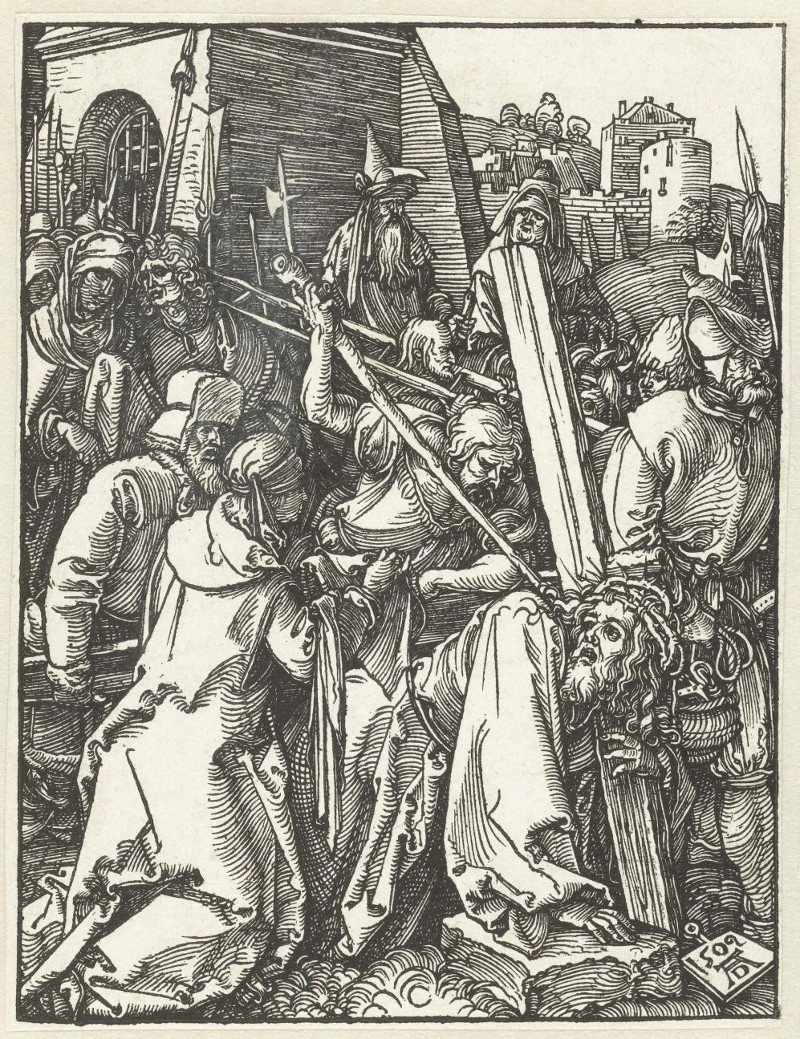
42. Dürer. The Way to Calvary. (Woodcut)
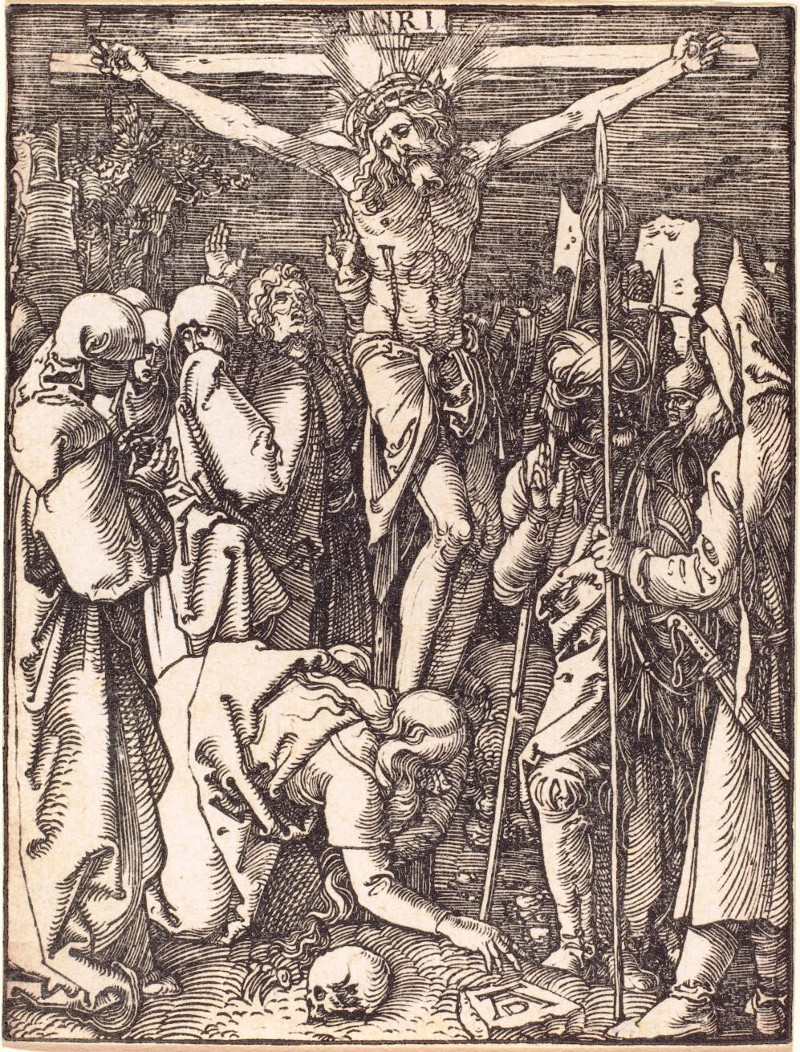
43. Dürer. Christ on the Cross. (Woodcut)

44. Dürer. Mourning for Christ. (Woodcut)

45. Dürer. The Resurrection. (Woodcut)

46. Dürer. The Ascension. (Woodcut)
We can also show two pictures
by Hans Baldung, who worked for a certain time, at any rate —
in Dürer's workshop. These pictures date from the end of the 15th
or beginning of the 16th century.
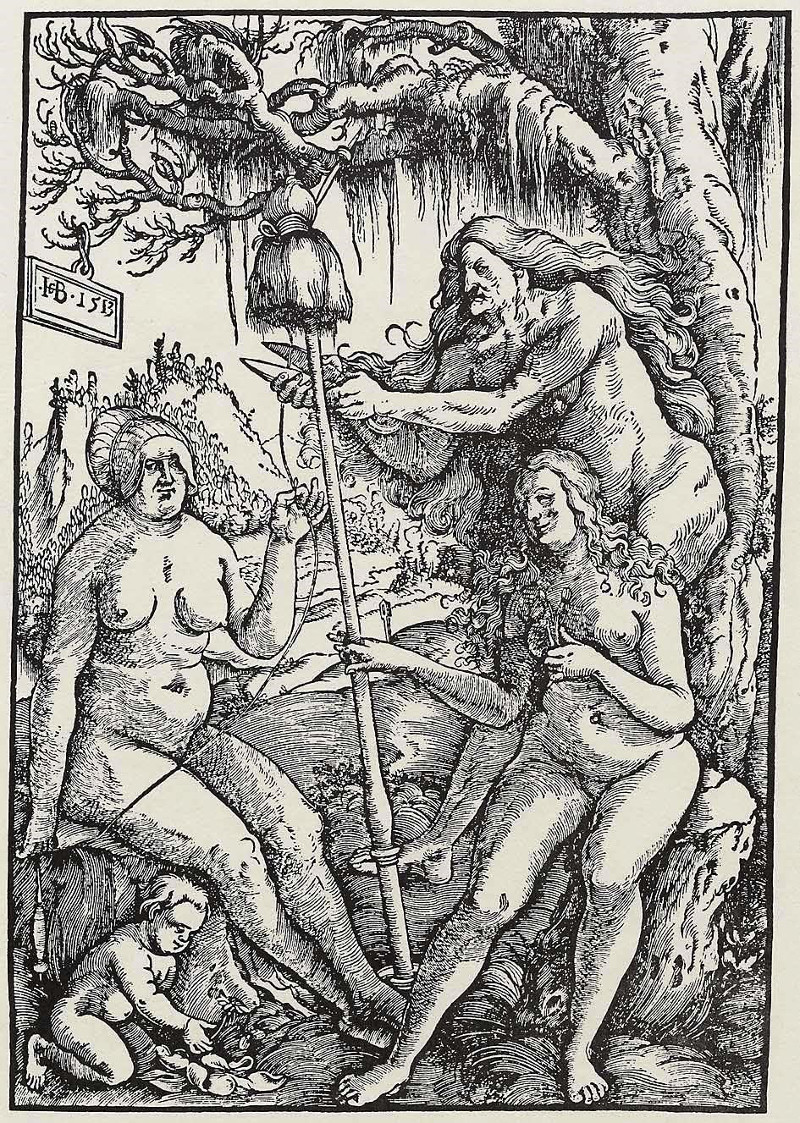
47. Hans Baldung. The Three Fates.

48. Hans Baldung. Ecce Homo.

49. Hans Sebald Beham. The Man of Sorrows.
I would like to make the
following remarks: — The transition from the Fourth to the fifth
post-Atlantean epoch and all that is connected with it, finds expression
— far more than we can realise from the ordinary textbooks of
History — in the whole life of the 12th, 13th, 14th, 15th, and
16th centuries. We must remember that at such times, at the turning-point
of one epoch and another, many things are perceptible in the life of
the time, expressing the mighty transformation that is taking place.
History, truly, does not take its course — though the text-books
might lead one to suppose so — like a perpetual succession of
causes and effects. At characteristic moments, at the turning-points
of epochs, characteristic phenomena emerge, in the most varied spheres
of life. Thus, at the transition from the age of the Intellectual Soul
or Soul of the Higher Feelings to that of the Spiritual Soul, phenomena
appear in all domains of life, revealing how men felt when the impulses
of the Spiritual Soul were drawing near. The evolution of the Spiritual
Soul involved the development of those relationships with the purely
physical plane into which men had to enter during the fifth post-Atlantean
age. To a high degree, man was about to be fettered to that physical
plane. Naturally, this brought in its train all the phenomena of reaction
— of opposition and revulsion at this process. Moreover, at the
same time many things emerged out of the former epoch, reaching over
with multitudinous ramifications into the new.
Among the many symptoms
of that time we see, for instance, the intense preoccupation of man
with the phenomenon of Death. In many different spheres — as we
can easily convince ourselves — the thought of Death came very
near to men. Death as a great mystery — the Mystery of Death —
drew near to men at the very time when their Souls had to prepare to
come out most of all on to the physical plane of existence.
Moreover. the things of
the fourth epoch were reaching over into the Fifth. There were the excesses
of the Papacy which had degenerated more and more into a pure impulse of
might. There were the excesses connected with the old divisions — the
riches of the higher orders, their overweening arrogance, their growing
superficiality of life, — while the religious themes themselves
were being made external, flat and superficial. Those human beings,
on the other hand, who attained some inwardness of soul were pondering
deeply on the penetration of the Spiritual world into the physical.
Added to this, there was the absolute need to turn one's attention to
the spiritual world; inasmuch as the seeds of decay and destruction
were entering most terribly into the physical world just at that time.
For in those centuries the plague was raging far and wide in Europe
— truly, an awful death, Death, in the Plague, came face to face
with men as a visible phenomenon in its most awful form.
In Art, too, we see this
intensive study of the significance of Death. It comes before us especially
in the famous Procession of Death on the cemetery wall at Pisa —
one of the earliest appearances of this kind. Then we find many pictures
of Death as it draws near to men under the inexorable laws of Fate —
draws near to man of whatsoever rank or class. The “Dance of Death,”
the “Wandering of Death through the World,” Death's entry
into all human relationships — this becomes a very favorite theme.
It was out of this mood and feeling that Holbein himself created his
cycle on the Dance of Death, three examples of which we shall now show.
In Holbein's Dance of Death the object was especially to show how Death
approaches the rich man, for instance; approaches man of every social
rank — from the highest in the land to the lowest. Moreover, the
object was to show Death as a righteous judge. Holbein in his Dance
of Death desired to show every conceivable circumstance under which
Death draws near to human life.
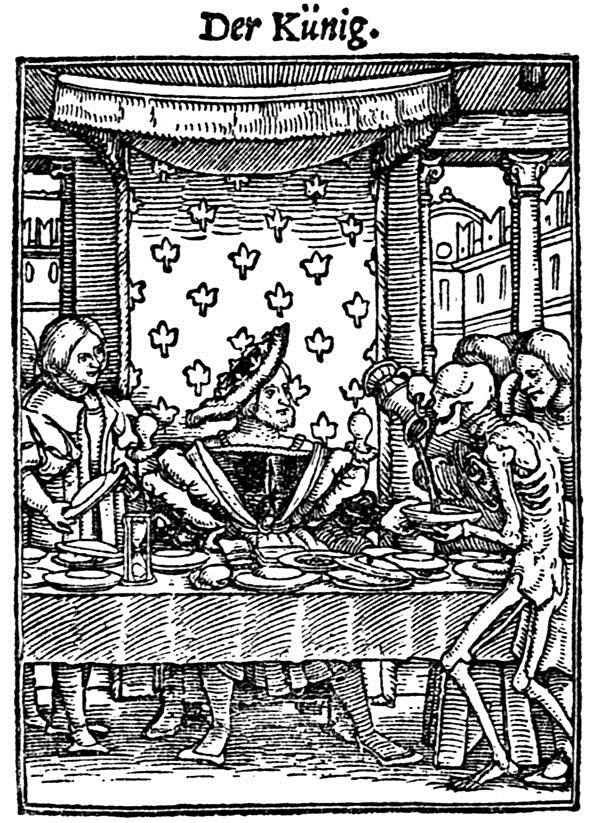
44a. Holbein. Death and the King.
Here we see Death coming
to the King, to tear him away from his royal life.

44b. Holbein. Death and the Monk.
The people of that time
had great delight in pictures such as these. This was the time when
the Reformation strove to put an end to all the growing worldliness
and emptiness of the religious life — to the corruption of the
Church and the religious orders.

45. Holbein. Death and the Rich Man.
Death draws near to the
rich man, and finds him with his pile of money.
My dear friends, we have
seen how the German Art came to expression in these great examples —
and especially in the greatest, in Dürer, — at the end of
the 15th and beginning of the 16th century. One question cannot but
interest us again and again: How is it with the origin and evolution
of this special stream of Art? In order to say a little more upon this
subject, we shall presently show a few pictures revealing how the several
factors stood at a characteristic moment. We can make very interesting
studies on the evolution of the Mid-European or German Art — and
notably the Southern German Art — at the beginning of the 15th
century. True, the pictures of the period, which we shall show, give
only the outcome of a long line of evolution. But this outcome appears
in them strongly and characteristically. When we wish to characterise
a great range of phenomena, we have to sum up many things in a few words;
and if we desire to be true, it is by no means easy ... It may be
that the characteristic pictures we choose does not fully represent
all that is here intended. But if we take things on the whole, we shall
find it is confirmed, undoubtedly.
The origin of the Mediaeval
Art of the German people shows itself most characteristically on the
slopes of the Alps reaching out into Southern Germany, into the regions
of Southern Bavaria and Swabia. And we must realise that here was a
flowing together of two factors. The one represented by all that was
imported from the South along the paths of evolution of the Church —
and notably the Roman Church system. We must decidedly imagine (though
the historic documents contain little about it) that in artistic matters,
too, many an impulse came through the Church and the clerical orders.
This applies especially to the districts to which I have just referred.
Undoubtedly, many priests and clerics also became painters — good
and bad — and they, of course, were always in close connection
with the whole system of the Church, working its way upwards with its
Roman, Latin impulses from the South. They carried with them all that
was living there as artistic tradition. Needless to say, this great
tradition reached its eminence only in men of genius, but it existed and
was taught as a tradition even among lesser men. Tradition was especially
at home in Italy, and thence the priests and monks absorbed and carried
it with them to the North.
With all the other things
which they derived from the Roman Church, they also took with them these
conceptions of how the artist should work, ideas of artistic harmony
and balance: Of how one ought to group the persons in a picture, and
how the lines should go, and so forth. All this that we see at its loftiest
eminence, say in the works of Michelangelo and, above all, Raphael,
too, did not create naively, but, as I said before, out of a far-reaching
artistic tradition. These artists knew how the figures should be grouped,
in the composition, how the single figures should be placed, and so forth.
And as I mentioned recently, they had brought the laws of perspective to
a high degree of perfection.
All this was taken Northward.
Monks and Priests who had enjoyed artistic training would frequently
discuss such things with those who showed signs of artistic talent.
But it must be said that the people whose home was in the German-speaking
districts of what is now called Austria or Southern Bavaria or Swabia
absorbed these rules of Art only with great reluctance. There can be
no doubt about it; they confronted many of these things without real
understanding. They heard that a thing must be done so, and so; but
it did not truly appeal to them, it did not strike home. They had not
yet developed in themselves a vision for these things. For a period,
from which little has been preserved, we must assume, proceeding from
these districts, works of Art carrying forward in a very clumsy fashion
whatever had to do with the great artistic tradition of the Latin, Roman
South. They could not enter into it; they had very little talent for it.
The talents of the people of these districts lay in another direction.
I have spoken of all that
was carried Northward by the Roman priesthood. This, as I said, was
the one factor. The other was what I would call the elemental originality
of heart and mind of the human beings themselves who in these regions
showed any kind of talent for the Art of painting. They had no talent
to follow the rules which were considered the highest requirements of
Art in the South. To begin with, they had no eye for perspective. That
a picture must somewhat express the fact that one figure is standing
more in the foreground and another towards the back, — this they
could only understand with great difficulty. To the people of these
districts in the first half of the 15th century the spatial conception
was still well nigh a closed book. Yet these very districts are in many
respects the source and fountainhead of German Art. They could not work
their way through to feel the laws of perspective independently and
of their own accord. At most, they felt that the things must somehow
be expressed by overlapping. The figure that overlaps the other is in
front, the other is behind. In this way they tried to bring some measure
of spatial order into their pictures, and so they began to find their
way into the laws of space.
Primitive as they still
are, we see in these pictures — appearing so characteristically
in the first half of the 15th century — how hard it is for that
stream of evolution which tries to take shape out of the elemental forces
of the human heart, to discover for itself the laws of artistic creation.
We will now show some examples from the above-mentioned districts. We
shall see that they had no real inner relation to the tradition that has
been brought to them. They absorbed it, as it were, unwillingly, with
reluctance. Nor had they yet the power to obey the laws of space out of
their own understanding. To begin with, I will show you an artist of the
first half of the 15th century: Lucas Moser.

46. Lucas Moser. The Voyage of Mary and Lazarus.
(Altar-piece at Tiefenbronn.)
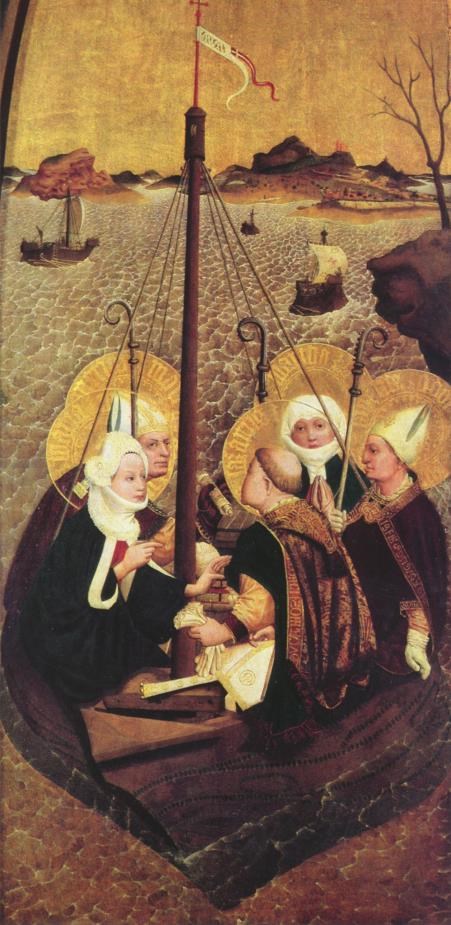
46. Lucas Moser. The Voyage of Mary and Lazarus.
(detail)
Here you see how difficult,
how well-nigh impossible the artist finds it to escape from the flat
surface. He seems quite unable to obey any kind of perspective law.
He creates out of the elemental forces of heart and mind, but his figures
are in the flat — he can scarcely get out of the plane. It is,
however, interesting for once to see something so primitive.
Lucas Moser was one of those
artists, creating within a social order wherein undoubtedly some of
the laws and canons of Art, that had been introduced from the South,
were living. Some element of the Southern style undoubtedly plays into
his works. At the same time he tries to contribute something of what
he sees for himself. And the one thing does not quite agree with the
other. For one does not actually see things in accordance with the laws
of Art.
Look at this Voyage of the
Saints across the Sea, as it is called. Look in the foreground (although
one can scarcely speak of a “foreground” here), — see
the water in which the ship is floating. The waves are merely indicated
by the crests, painted in lighter color. If you try to imagine a visual
point from which the whole picture might be seen, you will get into
difficulties at once. We must imagine it high up so as to look down
on the water. But that, again, will not agree with the aspect of the
figures of the saints, below.
On the other hand, you see
this artist is already striving towards what afterwards emerged —
as their essential greatness — in the German artists of a later
time, whom we have now considered. Look at the element of naturalism
— the faithful portrayal of expression in the faces of these saints.
And yet they are sitting on the very edge of the boat, so that they
would certainly fall overboard at the least breath of wind. In spite
of this, how intimate is the artist's observation; how delicately the
souls are expressed. He makes an unskillful attempt to observe the laws
of Art, and tries to be realistic at the same time, and the two things
do not agree ... Needless to say, the face could not be in this position,
in relation to the body (see the figure of the saint, with the mitre).
There are countless faults of the same kind. It is all clue to the fact
that the artist is striving on the one hand towards what afterwards
became the real greatness of the German Art, while on the other hand
he is impressed with certain rules. For instance: That there should
be a full-face figure in the middle of the picture, and others in profile
to contrast with it. He has been taught certain rules in arrangements
of composition. All this he tries his best to observe. But he can only
do so according to the measure of his own elementary conceptions. He has
not yet worked his way through to any kind of perspective or observation
of the laws of space.
Observe these little hills,
— and yet the picture does not really recede towards the background.
You will realise the immense progress that has been made by the time
of Dürer and Holbein. And yet how short was the intervening time!
This alter-piece was done in the first half of the 15th century. How
strongly the forces must have worked, overcoming the artistic traditions
imported from the South (for these they did not want) and bringing forth
a new stream out of an independent elemental impulse. They rebelled
against the Southern tradition and tended to overcome it, and to find
for themselves what they required. And you have seen how far they got
in a comparatively short time.
We will now show another
picture by the same artist.

47. Lucas Moser. Saints Asleep. (Marseilles.
From the Altar of Tiefenbronn.)
Look at this creation! It
shows how the artist combines a clear vision of Nature with an absolute
disregard of some of the simplest natural facts. The tiled roof and
the church tower — the whole ensemble is such that the artist
cannot possibly have seen it anywhere. He just puts it together, having
learned certain rules about the distribution of figures in space. Yet
look how he brings out the single items according to his own vision.
There is a decided beginning of Naturalism. He tries to be naturalistic
and yet to express what he feels should be. His subject is "Sleeping
Saints," but he conceives that they must appear worthy and dignified.
Look at the figure of St. Cedonius (?) here, with his mitre.

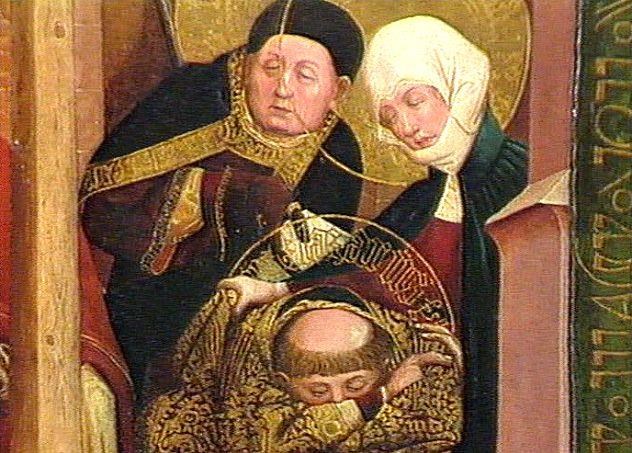
48. Lucas Moser. Saints Asleep. (Detail)


49. Lucas Moser. Self Portrait. (Detail)
Once more the whole thing
seems on the flat. But you will already observe the first attempt to bring
out of the spatial effects by the strong shadows thrown. His relations to
the laws of perspective are very strained, to say the least. But he
contrives to get the effect of space by the strong shadows, and altogether
by the distribution of light and dark.
This, as we saw in former
lectures, is a peculiar characteristic of the German stream, —
to feel the quality of space by catching the light, using the spatial
virtue of the light itself. Here we do not take our start from the laws
of lineal perspective — laws of perspective drawing. We extend
the surface forward and backward by discovering the hidden effects of
light itself.
We can see this most
significantly in another artist, who already seeks for truth of Nature,
but can still be characterised fundamentally in the same way as the former
one. I refer to Multscher.

50. Multscher. The Nativity. (Berlin.)
Here is a representation
of the Birth of Christ. Once again there is really nothing of those
Laws of Space that came from the South. But you see the beginnings of
the spatial working of the light itself. Space is born, as it were,
out of the activity of light, and in this element the artist works with
keen attention. This picture dates from 1437.
In Moser's and Multscher's
works we have a true artistic impulse, born out of the very nature of
the German South. Here is the element that afterwards rose to its height
in Dürer, Holbein and the rest, though the latter were also influenced
from Flanders and the Netherlands. The Cologne Masters, too, are rooted in
these same impulses. Again and again we see how wonderfully the
characteristics emerge even at the very beginning of the evolution of such
an impulse. Observe in this picture the striving to express the inner
quality of soul of every single person. And yet the artist's relation to
certain other truths of Nature is very strained; Imagine you were in this
crowd of people standing in the background. Look at the faces. Considering
how near some of them are, they could not be standing side by side in
that way unless their arms were chopped off, right and left; the artist
pays no heed to these elementary matters of spatial distribution. One
person is dovetailed into the other. The next is another picture by
Multscher.
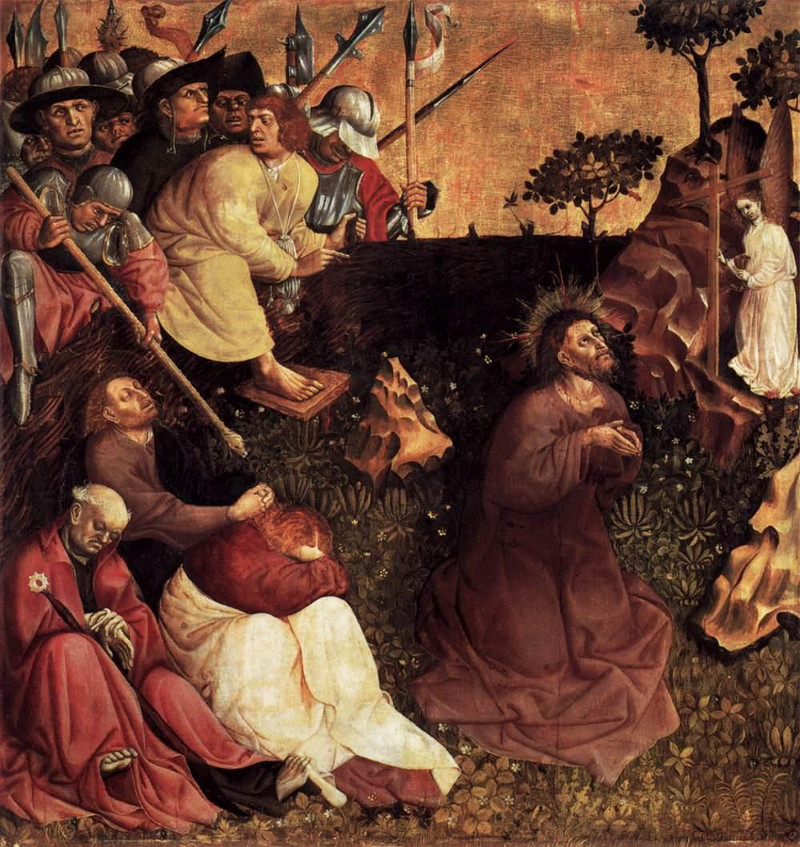
51. Multscher. Christ in Gethsemane. (Town
Hall. Sterzing.)
The artist tries to find
his way into the representation of landscape. Note how deeply he has
felt the three figures of the apostles, left behind. Yet how little he
succeeds in making any real distinction between foreground and background.
He seems almost unable to follow any of the laws of space. But he tries
once more to express the spatial by the effects of light. Here once
again we see the element which afterwards became so great in German
Art.

52. Multscher. The Entombment. (Stuttgart.
Museum.)
In Lucas Moser and in
Multscher we see the actual beginnings of German Art. There are others,
too, but very little has been preserved; most of it is to be found in the
churches. With all their primitive unskilfulness, we have here the
beginning of what emerged with real greatness in the pictures of a
later date, that we have seen. They paint out of a primitive feeling,
while they simply cannot find their way into the traditions that come
to them from the South. Their inwardness is in opposition to these laws
in which they are instructed. One more picture by Multscher.

53. Multscher. The Resurrection. (Berlin.)
All that we have said of
the two artists comes out very prominently in this picture. If you look
for a point from which these figures with the sarcophagus (for so we
might call it) are seen, you have to look high up above. We are looking
down on the whole scene. And yet if you look at the trees you will see,
they are seen from a frontal aspect. There is no single visual point
for the picture as a whole. The trees are seen from in front; the picture
as a whole, from above. There is no single point of vision according
to the laws of space. Indeed, whatever of perspective you do see in
the pictures would largely be eliminated were it not for the strong
differentiation of the space through the effects of the light itself.
In this respect, our eyes will easily deceive us. You would look in vain
for line perspective in this picture. You would find mistakes everywhere.
I do not mean naturally admissible mistakes, but errors which by themselves
would make the picture quite impossible. We see once more the striving
to get beyond the mere linear perspective by means of a spatial depth
and quality which the light itself begets.
We see how these artists of
Middle Europe have to feel their own way towards a totality of composition.
There is another interesting point, — less evident in these pictures,
but you will find it in other works by Multscher belonging to the same
altar-piece. His fine feeling for light enables him to bring out the
facial expression beautifully. But he is scarcely able to do the eyes
with artistic truth. You can see it here to some extent, though it is
less evident than on other pictures. And as for the ears — he
does them just as he has been taught. Here he does not yet possess a
free and independent feeling. Thus on the one hand he observes what
he has been told, but without much artistic understanding. The things
he does according to tradition he does badly. On the other hand, we
see in him, in a primitive form, what was only afterwards able to appear
more perfectly in German Art.
It is, indeed, remarkable
how all these things, which we find in the German Art, emerge already
in a highly perfect form in the Hamburg Master, Meister Francke, who
was practically a contemporary of Moser and Multscher.

54. Meister Francke. The Man of Sorrow. (Hamburg.)
In this Ecce Homo, this
Man of Sorrows, you see how high a degree of perfection the expression
of the Head of Christ, which was elaborated by and by in the course
of time, had already reached. Compare this Head of Christ with the one
by Multscher which we saw just now. You will recognise a great advance.
Likewise, in the whole forming of the figures. Of course, the peculiar
quality which afterwards came out through greater skill and variety
of technique in Dürer's work, — in his paintings, etchings
and woodcuts, — is lacking still.
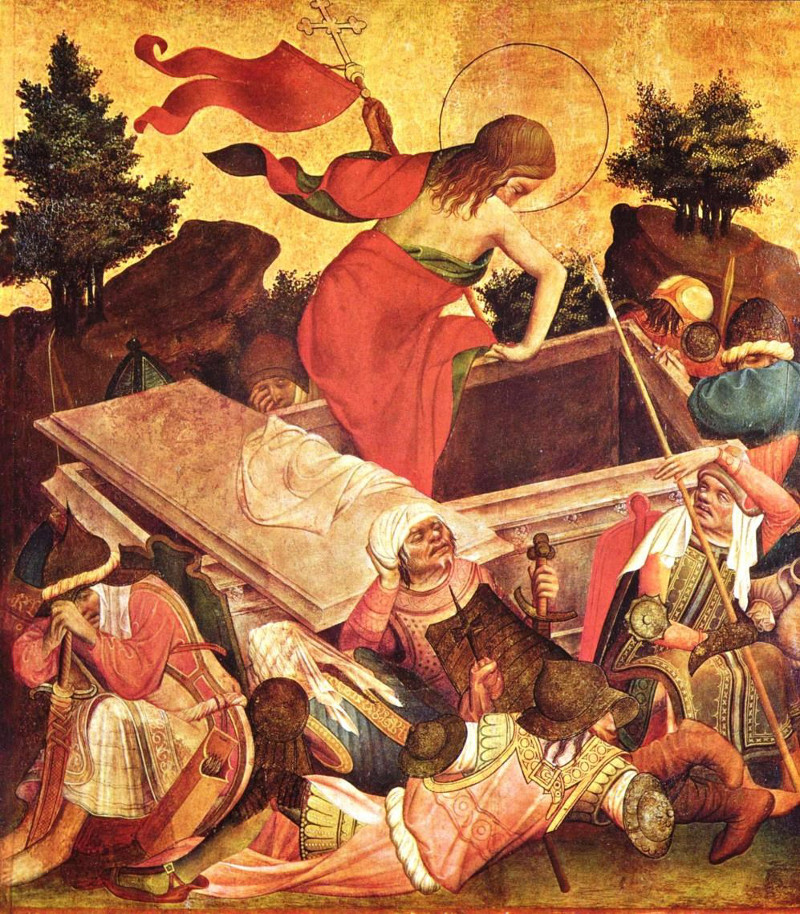
55. Meister Francke. The Resurrection. (Schwerin.)
All in all, considering
the artistic developments that are potentially there in these first
beginnings, and that produced Dürer and Holbein and the others,
we must admit that the thread is broken. For afterwards there came a
break; they turned back again to the Roman, Latin principle. And in
the 19th century, artistic evolution was decidedly on a retrogressive
path. There can, however, be no doubt that this fact is connected with
deep and significant laws of human evolution. This stream of evolution
in Art works out of the element of light and dark, and discovers —
as I tried to explain in the lecture on Rembrandt — the inner
connection of the world of color with the light and dark. Through the
historic necessity of the time, it could not but tend towards a certain
Naturalism; but it can never find its culmination in Naturalism. For in
this peculiar talent to perceive the inwardness of things, the possibility
to paint, to represent the spiritual Mysteries, still lies inherent.
When I say “inwardness of things,” I mean not merely inwardness
of soul, but the inwardness of things themselves, expressed in the spatial
laws of light and darkness which also contain the mysteries of color.
Goethe, as you know, tried to express this systematically in his Theory
of Color. This possibility, therefore, still lies open and unrealised
in evolution. The possibility to paint the spiritual Mysteries out of
the inner virtues of the world of color, out of the inner essence of the
light and dark. And the possibilities in this direction can be extended
also to the other Arts.
But such a thing can only
be brought about through the inspiration of Spiritual Science, of the
anthroposophical conception of the world. In the none too distant future,
the possibilities that lie inherent in the beginnings of this stream
of Art must all be brought together. To create out of the inner light
— out of the forming and shaping power of the light — will
at the same time be to create out of the inner source of being, and
that, I need not say, can only be the Spiritual. In the portrayal of
the sacred History, this stream in Art could not, in the nature of the
case, attain the high perfection which Raphael attained, for instance.
(Nevertheless, in some respects it attained a perfection of its own
— notably in the great artists whose works we have seen again
today.) But the Spiritual that pervades the works of this Art is still
alive. We must only find the connection of what surges through these
works of Art, with the underlying laws of the spiritual life. Then will
spiritual Imagination and artistic fancy join together and create a
true Imaginative Art.
To some extent, as a first
beginning, this has been attempted in our (Goetheanum) Building. For
this is, after all, a beginning of new artistic impulses. Naturally,
there is something primitive about every new beginning; but we have
ventured, none the less, to strive for something new and in a grander
style. The time may come when people will understand what we have been
striving for in this Building. Then it will be realised why certain
occult impulses that came already to expression in this art which we
have seen today and in the preceding and contemporary sculpture (examples
of which we have also seen) remained to this day unrealised. It will
be understood why a certain break was inevitable in the evolution of
this art. How remote, after all, is that which emerges in the 19th century
in the art of a Kaulbach or a Cornelius from what is living in this
art which we have seen today! In Kaulbach, Cornelius, Overbeck and the
rest, we see a mere repeat of the Southern element. In this art, on
the other hand, we see on all hands a radical rebellion and revolution
against the Latin and Roman.
He who is prepared to look
more closely, will find still deeper connections. Think of the four
pictures by Multscher which we have shown today. They represent, if
I may say so, the native Swabian tendencies in the realm of Art. Here
we find a certain native talent for a flat surface with the help of
light. Anyone who has a feeling for finer, more intimate relationships
will perceive a similar quality in the Philosophy of Hegel — likewise
a product of the Swabian talent, and in that of Schelling, of whom the
same thing may be said, and in the poetry of Holderlin.
This grasp of the flat
surface, but working forth from the flat surface with the help of light,
— we find it not only in the primitive beginnings of this art; we
find it again even in Hegel's Philosophy. Hence Hegel's Philosophy, if I
may say so, makes such a ‘flat’ impression on us. It is
like a great canvas, like an ideal painting of the world. It works from
the surface; and in its turn, after all, it can but be the philosophic
beginnings of what will now work its way — not merely into this
projection of Reality on the flat — but into the full Reality
itself. And this “Reality,” I need not say, can be none
other than the Spiritual.
These things are interrelated
in all truth. What I have lately been trying to describe to you for
other realms of life, with regard to the history and civilisation of
Europe, is wonderfully confirmed, in all detail, in the sphere of Art.
All that we recognised in the lecture the day before yesterday —
the impulses working in the different regions of Europe — you
can trace it again in the life of Art. Bring before your minds again
the art of the Netherlands which we have seen, — coming from thence
into Western Germany. Then consider what we have studied today —
as something growing absolutely and originally out of the German spirit
itself. For the country of which we have spoken today, the soil on which
Lucas Moser and Multscher worked, is, after all, the central region
of the German Spirit. It is here that the German Spirit has evolved
most originally and most truly. Here, too, Christianity was inwardly
absorbed, as though by an inner kinship with the spiritual nature of
the German heart and mind. The absorption of Christianity was a far
more inward process in these districts; and here the original and elemental
gifts of the German nature came forth in the realms of Art. They did
not accept what brought Christianity to them from the South in a form
already marred by Rome; they tried to recreate Christianity themselves
artistically out of their inner heart and feeling.
Such a thing could not emerge
in the same measure in the more Northern regions of Germany without
the coming of an impulse from the South. We see the same thing once
more in the fact that Hegel's philosophy received its quickening from
the Southern region, and Schelling's too; while, on the other hand,
the philosophy of Kant reveals itself quite evidently as a North German
product. The peculiar quality of the Kantian philosophy is not unconnected
with the fact that the originally Prussian districts remained Heathen
for comparatively long. They were brought over to Christianity at a
later period and by a rather external process — a conversion far
more external than in the Southern German districts. Prussia, properly
speaking, remained Heathen till a very late period.
The things we otherwise
recognise in historic evolution — we can find them confirmed in
the evolution of Art and in the evolution of the life of Thought. For
this very reason I wanted to place Moser and Multscher before you at
the close of our considerations for today.
|